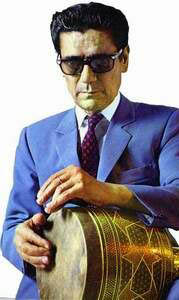Tonbak
The Doumbek
page | Rhythmweb HOME
 "…When
I started playing on zarb, the instrument had fallen
into disrepute. The zarb player was considered a low-level
musician, a joke; no one dared to want to play zarb. To
do so was to give up all prestige, all respect as a musician.
Nonetheless, I began to play it. Love for the instrument
outweighed the derision and scorn. At this time, I decided
that I should change this negative view in any way possible.
To this end, I practiced the zarb incessantly." "…When
I started playing on zarb, the instrument had fallen
into disrepute. The zarb player was considered a low-level
musician, a joke; no one dared to want to play zarb. To
do so was to give up all prestige, all respect as a musician.
Nonetheless, I began to play it. Love for the instrument
outweighed the derision and scorn. At this time, I decided
that I should change this negative view in any way possible.
To this end, I practiced the zarb incessantly."
Ostad Hosain Tehrani
from his book, 'Amouzesh-e-Tombak'
(Our thanks to Peyman Nasehpour for allowing us to publish this
short article on the tonbak here at Rhythmweb. For more on Peyman's
work click
here.)
Tonbak (Zarb): A Brief History
by Peyman Nasehpour
Introduction
Knowing and appreciating the history of the Tonbak may
not be essential to being a great tonbak player. For some,
it may not even be of interest. But I believe that understanding
and being familiar with the history of music and its musicians
gives one a broader perspective, and a more comprehensive
view of what it means to be a musician. In this article
I will try to give a brief history of the Tonbak.
The Tonbak (also called Zarb, the Persian goblet
drum) and the Daf (the Kurdish frame drum) are the only
national drums of Persia. Also the presence of goblet drums
in Asia, North Africa and East Europe shows the importance
of this class of drums. Unfortunately, the origin of the
Tonbak is still in dispute. Etymologists say that the Pahlavi
(Persian pre-Islamic language) name of the Tonbak is 'Dombalag',
and it was known to be present in the Zourkhaneh (the Persian
traditional gymnasium) so we know that it is ancient, pre-dating
the Islamic period. Various names for the Tonbak, throughout
its history, trace the application of this instrument in
different parts of ancient Persia. For a lexical discussion
please refer to the article section of the Tombak Network.
There is a very good ancient manuscript (Kanz-al-Tohaf,
by Hassan Kashani) on theoretical Old Persian music, in
which, at the end of the book, the author tries to describe
the methods of making the various musical instruments of
his time. But unfortunately he has not included the drums
(particularly the Tonbak) in his descriptions. Still, our
information about the Tonbak and tonbak players of the Ghajar
period is sufficient, thanks to two important books on the
history of Persian art music ([KH] and [M]).
Ostad Hosain Tehrani
The Tonbak before the late Ostad Hosain Tehrani was considered
as an accompaniment instrument that was played by tasnifkhan-s
(tasnif performers). Here I should explain that in Ghajar
period vocalists were of two kinds: avazkhan and tasnifkhan.
The Avazkhan's job was to sing the non-rhythmic compositions
of Persian radif repertoire and the Tasnikhan's job was
to sing the rhythmic compositions of Persian art music.
The first person that tried to give an independent role
to tonbak was Ostad Hosain Tehrani. He devoted his life
to promote the Tonbak in Iran and Europe. Along with the
help of some other musicians, he also wrote the first instructional
book for the Tonbak, i.e. [T].
The skin of the Tonbak is quite sensitive to changing humidity.
This was a problem for every tonbak player. He asked Ostad
Ebrahim Ghanbari-mehr (maker and designer of musical instruments)
to find a solution for this problem. In fact Ostad Ebrahim
Ghanbari-mehr was introduced to Ostad Hosain Tehrani by
Ostad Abol-Hasan Saba (multi-instrumentalist). This resulted
in Ostad Ebrahim Ghanbari-mehr designing the tonbak-e-kouki
(tunable tonbak). Alas, this kind of tonbak has not a good
luck. It seems that tonbak players prefer not to use tonbak-e-kouki.
Tonbak players today still tune mostly by the old method,
garm-kardan-ru-ye-atash (i.e. heating in front of a fire).
A Bright Future
Step by step the Tonbak has gained respectability as a
serious instrument. Ostad Tehrani's activities have stirred
interest in the Tonbak, throughout Iran and Europe. The
efforts of Ostad Tehrani and the other tonbak players (particularly
Ostad Nasser Farhangfar) have assured that the Tonbak has
a secure place in instrumental music. Before these artists,
the Tonbak was little more than a metronome! Fortunately
I am able to say that today the public image of tonbak is
really very good. Many young players promote it.
Some tonbak players have even started integrating tonbak
into fusion music ensembles. Perhaps this type of music
is not of interest to those who only like pure Persian art
music, but still, the drum's use in fusion music can only
mean one thing: more worldwide popularity for the Tonbak.
And judging by the number of tonbaks sold by the manufacturers,
the number of books being written on the Tonbak, and the
number of young people who enjoy it, it seems that the Tonbak
has a very bright future indeed. May it be so!
Acknowledgement. The author wishes to thank Eric
Stuer for his edition.
References
[KA]: Hassan Kashani, Kanz-al-Tohaf, by effort of M.T. Binesh,
Tehran, 1992.
[KH]: Ruhollah Khaleghi, Sargozasht-e-Musighi-ye-Iran, Tehran,
1974.
[M]: Hassan Mashhoun, Tarikh-e-Musighi-ye-Iran, Tehran,
1994.
[N]: Peyman Nasehpour, Personal Interview with Ostad Fereydun
Helmi (tonbak maker), Tehran, 2001.
[P]: Mehran Poormandan, The Encyclopedia of Iranian Old
Music, Tehran, 2000.
[T]: Hosain Tehrani, Amouzesh-e-Tombak (Tombak Rudiment),
Tehran, 1970.
For more resources, check the Doumbek
Page at Rhythmweb.
|

